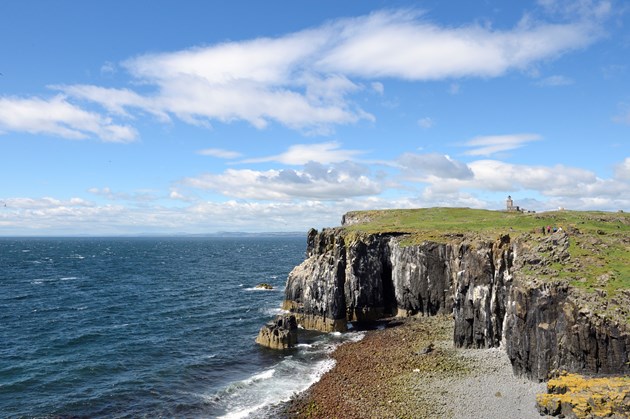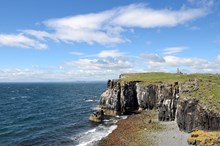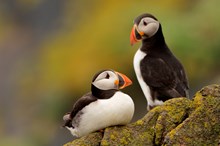05 August, 2022
Isle of May NNR to re-open as seabirds leave

After five weeks of closure, NatureScot’s Isle of May is re-opening to public landings from Monday, as the majority of seabirds have left the island. Some restrictions and biosecurity measures will remain however.
The island, a National Nature Reserve, was closed to help protect vulnerable seabird populations from the spread and impact of the current H5N1 strain of avian flu in seabird colonies.
The breeding season is now over for most species on the Isle of May, and they have left the island to overwinter at sea or moved to the nearby coast before migrating further afield. It’s not yet possible to assess how much the current outbreak of avian flu has impacted on the island’s breeding populations, but some species have successfully bred.
Visitors to the island will be asked to remain on paths, and biosecurity measures will be in place on boats and on the island. The virus has been found to stay on the ground and in bird faeces for a long time, so restricting access to any areas that still have nesting seabirds and taking simple steps to disinfect boots and clean clothing is crucial.
Seabird colonies on 23 other islands around Scotland remain closed to public landings, as they are still home to hundreds of thousands of breeding seabirds. At other coastal NNRs such as Hermaness in Shetland, NatureScot has asked visitors not to walk through seabird colonies but to enjoy the spectacle from a distance. Local signage is in place at those reserves affected.
Seabird breeding seasons vary significantly between species with some, such as gannets and storm-petrels, remaining at colonies until mid-October. The breeding seasons may also vary in different parts of the country by several weeks. NatureScot is keeping the situation under constant review on a site-by-site basis. Restrictions will be lifted as soon as possible in discussion with site managers.
Eileen Stuart, NatureScot’s Deputy Director of Nature & Climate Change, said: “We hope the restrictions limited the spread of avian flu on the Isle of May, although more research is needed to confirm this in the coming months. We are grateful for the ongoing support from local boat operators during this challenging period.
“On those islands which are still occupied by nesting seabirds, we’d ask for patience, as the restrictions are our best chance to reduce the spread of this deadly virus. We recognise that this will be disappointing for those planning a visit, but we hope people understand that this is about protecting our precious seabird populations for the future. We will continue to keep the situation under regular review over the coming weeks.”
ENDS
Contact information
- Name
- NatureScot Media
- Telephone
- 0131 316 2655
- media@nature.scot
Notes to editors
The public is asked to report all sightings of sick or dead bird to DEFRA on 03459 33 55 77 so that a complete picture can be built. Members of the public should avoid touching sick or dead wild birds. Visitors to coastal areas are encouraged to keep dogs on a lead to avoid them touching or picking up dead birds. More detailed information is available on the Scottish Government website.
NatureScot, in discussion with the British Trust for Ornithology (BTO), has suspended ringing and research activities in seabird colonies for the remainder of the breeding season, with the exception of essential surveillance of avian flu.
Surveillance monitoring is being coordinated at key sites and NatureScot is working at speed with the Scottish Government and conservation organisations to develop an effective overall strategy. Central to NatureScot’s role is gaining a better understanding of the changing situation, to inform action to help populations recover.
The current situation follows a large outbreak in Svalbard barnacle geese last winter where H5N1 is estimated to have killed 30-40% of the wintering population.
Avian flu has been found across species with positive reports from pink-footed geese, buzzards, mute swans, a red kite and a sea eagle for example. It is unfortunately amongst breeding seabird colonies where currently the most significant and worrying mass mortality events are occurring.
NatureScot is Scotland's nature agency. We work to enhance our natural environment in Scotland and inspire everyone to care more about it. Our priority is a nature-rich future for Scotland and an effective response to the climate emergency. For more information, visit our website at www.nature.scot or follow us on X at https://x.com/NatureScot
’S e NatureScot buidheann nàdair na h-Alba. Bidh sinn a’ neartachadh àrainneachd na h-Alba agus a’ brosnachadh dhaoine gu barrachd suim a chur ann an nàdar. Tha e mar phrìomhachas againn gum bi nàdar na h-Alba beairteach agus gun dèilig sinn gu h-èifeachdach le èiginn na gnàth-shìde. Tha an tuilleadh fiosrachaidh aig www.nature.scot no air X aig https://x.com/NatureScot



